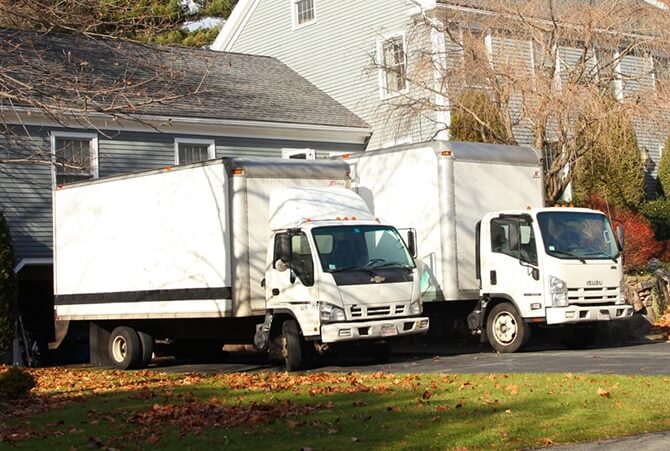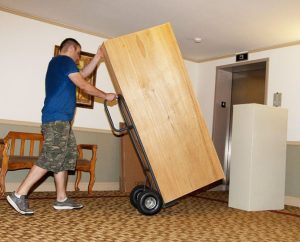Why are moving trucks so hard to drive?
Small trucks, and all trucks for that
So, trucks are much harder to drive and control than most people are used to and yet, state licensing authorities allow people with only an auto license to drive them legally. The differences between a truck and an automobile are huge and anyone driving a truck needs to be aware of them.
Trucks have bigger engines than passenger vehicles because of the weight they have to move around. Bigger engines with a lot more power are needed to move all this weight around. Trucks also have bigger wheels and bigger brakes for the same reason. In fact, just about everything about a truck is bigger than what’s on passenger vehicles.
When you are driving a truck, you are working in a much larger environment than you are used to – so you have to think bigger all of the time.
The bigger the vehicle, the more the weight, the more the power, the bigger the brakes, the bigger the other components, the more the occupied cubic road space, the more the room needed to operate the vehicle, the more the room needed to stop it and the more the overhead clearance room needed under overpasses and viaducts. Therefore, open your mind to all of the bigger things about trucking.
Truck accidents can be very expensive and can easily erase any $$$ savings you are planning to achieve by moving yourself. Consequently, people who are renting a truck to move themselves need to at least do a little studying on truck usage for safety’s sake before they ever try to drive one. And they need to take insurance from the truck rental company, just in case, because the few dollars spent on insurance will be well worth it if an accident occurs.
Truck Safety When Moving
Ramp and Liftgate Safety
Many people fall off of truck ramps and injure themselves every year because they simply do not pay enough attention while they are traversing it. Or they get injured because of slippery weather conditions. Sometimes they are dollying a heavy piece with only 1 person on the heavy end and it overwhelms them and hurts them. Always wear good gripping shoes and be careful
Lift gates have been known to injure people too. If at least 2 people are not standing on the ground to reach up and hold a big piece in place as it is raised or lowered, it can slip off and hurt them. Watch your feet also because the lift can be lowered onto your foot and crush it or if you’re up on top of it, as it butts into the truck’s deck, your foot can get caught.
Getting In and Out of a Moving Truck
Many, many injuries occur to people each year just getting into or out of a truck’s door. Remember truck doors are high up and it’s easy to fall enough to strain or sprain or break an ankle. Always use 2 hands and one well-placed foot to lift/lower yourself in/out of the truck’s door. That way, if your foot does slip for some reason, you can recover with your grip of 2 handholds. Without 2 handholds, you will fall easily.
Mirror Safety
Do not attempt to drive anywhere without having both side mirrors well- adjusted to your vision. These both mirrors are your only means of watching the traffic around you. And be sure to remember that you have a big blind spot on the passenger side and directly behind you.
Clearances – Horizontal and Vertical
Many times each year, uninitiated drivers tear the roof off of their rental trucks because they are used to driving a car so they’re not trained to watch for height clearances. They don’t watch for enough clearance under bridges and/or viaducts and bingo, all of a sudden the roof is shearing off.
When turning, a truck can cut into something on its turn side so to avoid that, always make wide swings on turns. The truck also has a big back end to clear, so take it slow and watch your mirror on the opposite side of the turn to be sure you don’t hit something with it.
Interval
Truck drivers should always leave a big gap in front between them and the next car to allow for enough emergency stopping room. Leave at least 1 truck length per 10 miles per hour for safety’s sake. Leave
Backing up a Moving Truck
It is always best to have a spotter in the back when backing up. The driver should follow their guidance by watching their signals through the mirrors. The spotter should always make sure he or she can see the driver’s face in one mirror or the other as the truck backs up. This assures that the driver can see them.
The truck’s windows should be open so that the driver can hear the spotter’s shouted voice guidance. The spotter should always also be near one of the back sides of the truck so that they can slap the truck hard to emergency signal the driver to stop immediately. Spotters need to watch side clearances and top clearances.
Spotters should normally stay on the passenger side of the truck with its blind spots because the driver can’t see as well over there. The driver can see much better on their side of the truck and normally won’t need much guidance there.
The driver should back up very slowly for safety’s sake. He should follow the spotter’s signals or they should stop the truck, put the emergency brake on, get out and walk around the truck to survey the situation.
Parking and Double Parking the Truck
Truck drivers should always use a spotter to back into a parking spot. They should then position the truck in the parking spot with the wheels close to the curb. If the truck is parked on an incline, the front wheels should be turned in such a way as to stop the truck against the curb (front of truck on top of incline = back of front wheel turned in to curb, front of truck at bottom of incline = front of front wheel turned in to curb).
Double parking a truck should be done so that the truck is very close to the parked cars so as to allow traffic to get by more easily. When double parked, be careful to keep all moving personnel from wandering outside of the truck’s width where they can be injured by traffic.
Bad weather
Bad weather of all kinds can strongly affect your truck driving so turn on your headlights. In rain, keep a bigger interval and make sure your wipers work well so you can see as far as possible. Try not to move in sleet, hail or snow but if you must, plan to go very slowly and carefully. Bring shovels and salt in case you get stuck somewhere. Remember, you can’t push a truck out of a stuck spot like you can a car. And if you slip off into a ditch plan on at least $300.00 for a tow.
Road Hazards
There are more road hazards for trucks than for cars. Just be careful of them. As soon as you spot any unusual road condition ahead, begin to slow down and go on the alert. Be sure you have flares or triangles in your truck in case you become a road hazard yourself.
Road Rage
People get very enraged at truck drivers very easily. Those in cars just do not like having a big truck around anywhere when they are on the road. Automobile drivers will cut trucks off or honk and swear as they race by. It’s best to just back off from such situations in order to defuse potentially dangerous or illegal road rage encounters.
Security
Be sure to keep all doors on the truck locked at all times. Purchase a good padlock for the cargo door and keep it locked whenever you have to be away from the truck, even if it’s only for brief periods because of thieves. Lock all coats and valuables in the cargo area of the truck.
Driving a rental truck across the country is riskier than you think, so it’s much better to leave this job to professional movers. This way, you will eliminate all the stress and dangers from your residential move.


